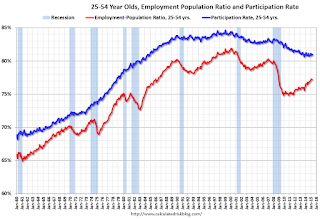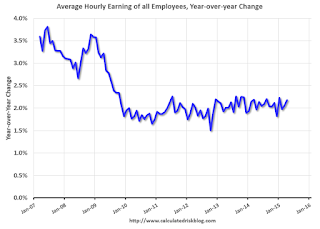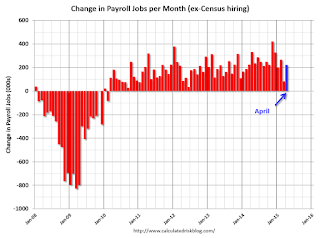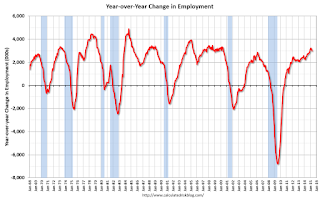by Calculated Risk on 5/08/2015 11:52:00 AM
Friday, May 08, 2015
Employment Report Comments and Graphs
Earlier: April Employment Report: 223,000 Jobs, 5.4% Unemployment Rate
This was a decent employment report with 223,000 jobs added, but February and March were revised down by a combined 39,000 jobs.
However there is still limited wage growth, from the BLS: "In April, average hourly earnings for all employees on private nonfarm payrolls rose by 3 cents to $24.87. Over the past 12 months, average hourly earnings have increased by 2.2 percent." Weekly hours were unchanged.
A few more numbers: Total employment increased 223,000 from March to April and is now 3.0 million above the previous peak. Total employment is up 11.7 million from the employment recession low.
Private payroll employment increased 213,000 from March to April, and private employment is now 3.5 million above the previous peak. Private employment is up 12.3 million from the recession low.
In April, the year-over-year change was just under 3.0 million jobs.
Overall this is another positive month ... and moving in the right direction!
Employment-Population Ratio, 25 to 54 years old

In the earlier period the participation rate for this group was trending up as women joined the labor force. Since the early '90s, the participation rate moved more sideways, with a downward drift starting around '00 - and with ups and downs related to the business cycle.
The 25 to 54 participation rate increased in April to 81.0%, and the 25 to 54 employment population ratio was unchanged at 77.2%. As the recovery continues, I expect the participation rate for this group to increase a little more (or at least stabilize for a couple of years) - although the participation rate has been trending down for this group since the late '90s.
Average Hourly Earnings

The blue line shows the nominal year-over-year change in "Average Hourly Earnings" for all private employees. Nominal wage growth increased slightly to 2.2%, however wages were revised down for February and March. Wages will probably pick up a little this year.
Note: CPI has been running under 2%, so there has been some real wage growth.
Part Time for Economic Reasons

The number of persons employed part time for economic reasons (sometimes referred to as involuntary part-time workers) was little changed at 6.6 million in April, but is down by 880,000 from a year earlier. These individuals, who would have preferred full-time employment, were working part time because their hours had been cut back or because they were unable to find a full-time job.The number of persons working part time for economic reasons decreased in April to 6.58 million from 6.70 million in March. This suggests slack still in the labor market. These workers are included in the alternate measure of labor underutilization (U-6) that decreased to 10.8% in April from 10.9% in March. This is the lowest level for U-6 since August 2008.
Unemployed over 26 Weeks
 This graph shows the number of workers unemployed for 27 weeks or more.
This graph shows the number of workers unemployed for 27 weeks or more. According to the BLS, there are 2.525 million workers who have been unemployed for more than 26 weeks and still want a job. This was down from 2.563 million in March.
This is trending down - and is at the lowest level since November 2008 - but is still very high.
State and Local Government
 This graph shows total state and government payroll employment since January 2007. State and local governments had lost jobs for four straight years. (Note: Scale doesn't start at zero to better show the change.)
This graph shows total state and government payroll employment since January 2007. State and local governments had lost jobs for four straight years. (Note: Scale doesn't start at zero to better show the change.) In April 2015, state and local governments added 8,000 jobs (after losing 8,000 in March). State and local government employment is now up 132,000 from the bottom, but still 626,000 below the peak.
State and local employment is now generally increasing - slowly. And Federal government layoffs have slowed (Federal payrolls added 2,000 jobs in April, and Federal employment is unchanged year-to-date).
This was a decent employment report for April (not great, but not terrible). The year-over-year employment gains are still solid.
April Employment Report: 223,000 Jobs, 5.4% Unemployment Rate
by Calculated Risk on 5/08/2015 08:35:00 AM
From the BLS:
Total nonfarm payroll employment increased by 223,000 in April, and the unemployment rate was essentially unchanged at 5.4 percent, the U.S. Bureau of Labor Statistics reported today. Job gains occurred in professional and business services, health care, and construction. Mining employment continued to decline.
...
The change in total nonfarm payroll employment for February was revised from +264,000 to +266,000, and the change for March was revised from +126,000 to +85,000. With these revisions, employment gains in February and March combined were 39,000 lower than previously reported.
emphasis added
 Click on graph for larger image.
Click on graph for larger image.The first graph shows the monthly change in payroll jobs, ex-Census (meaning the impact of the decennial Census temporary hires and layoffs is removed - mostly in 2010 - to show the underlying payroll changes).
Total payrolls increased by 223 thousand in April (private payrolls increased 213 thousand).
Payrolls for February and March were revised down by a combined 39 thousand.
 This graph shows the year-over-year change in total non-farm employment since 1968.
This graph shows the year-over-year change in total non-farm employment since 1968.In April, the year-over-year change was just under 3.0 million jobs.
This is a solid year-over-year gain.
 The third graph shows the employment population ratio and the participation rate.
The third graph shows the employment population ratio and the participation rate.The Labor Force Participation Rate increased in April to 62.8%. This is the percentage of the working age population in the labor force. A large portion of the recent decline in the participation rate is due to demographics.
The Employment-Population ratio was unchanged at 59.3% (black line).
I'll post the 25 to 54 age group employment-population ratio graph later.
 The fourth graph shows the unemployment rate.
The fourth graph shows the unemployment rate. The unemployment rate was declined in April to 5.4%.
This was at expectations of 220,000, however there March was revised down ... still a decent report.
I'll have much more later ...
Thursday, May 07, 2015
Friday: Jobs, Jobs, Jobs
by Calculated Risk on 5/07/2015 07:42:00 PM
Here is the employment preview I posted earlier: Preview: Employment Report for April
Goldman Sachs is forecasting 230,000 jobs added, and for the unemployment rate to decline to 5.4%.
Merrill Lynch is forecasting 235,000 jobs added in April, and the unemployment rate declining to 5.4%.
Nomura is forecasting 210,000 jobs, a 0.28% increase in wages month-to-month, and a 5.4% unemployment rate.
Friday:
• At 8:30 AM ET, the Employment Report for April. The consensus is for an increase of 220,000 non-farm payroll jobs added in April, up from the 126,000 non-farm payroll jobs added in March. The consensus is for the unemployment rate to decline to 5.4%.
Phoenix Real Estate in April: Sales Up 9.3%, Inventory DOWN 13% Year-over-year
by Calculated Risk on 5/07/2015 05:31:00 PM
For the fifth consecutive month, inventory was down year-over-year in Phoenix. This is a significant change from last year.
This is a key distressed market to follow since Phoenix saw a large bubble / bust followed by strong investor buying. These key markets hopefully show us changes in trends for sales and inventory.
The Arizona Regional Multiple Listing Service (ARMLS) reports (table below):
1) Overall sales in April were up 9.3% year-over-year.
2) Cash Sales (frequently investors) were down to 25.3% of total sales.
3) Active inventory is now down 13.2% year-over-year.
More inventory (a theme in 2014) - and less investor buying - suggested price increases would slow sharply in 2014. And prices increases did slow.
Now, with falling inventory, prices might increase a little faster in 2015 (something to watch if inventory continues to decline).
| April Residential Sales and Inventory, Greater Phoenix Area, ARMLS | ||||||
|---|---|---|---|---|---|---|
| Sales | YoY Change Sales | Cash | Percent Cash | Inventory | YoY Change | |
| Apr-08 | 4,8751 | --- | 986 | 20.2% | 55,7261 | --- |
| Apr-09 | 8,564 | 75.7% | 3,464 | 40.4% | 44,165 | -20.7% |
| Apr-10 | 9,261 | 8.1% | 3,641 | 39.3% | 41,756 | -5.5% |
| Apr-11 | 9,328 | 0.7% | 4,489 | 48.1% | 34,515 | -17.3% |
| Apr-12 | 8,438 | -9.5% | 4,013 | 47.6% | 21,125 | -38.8% |
| Apr-13 | 8,744 | 3.6% | 3,670 | 42.0% | 20,083 | -4.9% |
| Apr-14 | 7,656 | -12.4% | 2,469 | 32.2% | 29,889 | 48.8% |
| Apr-15 | 8,368 | 9.3% | 2,120 | 25.3% | 25,950 | -13.2% |
| 1 April 2008 does not include manufactured homes, ~100 more | ||||||
Goldman Sachs April Employment Preview
by Calculated Risk on 5/07/2015 03:15:00 PM
Yesterday I discussed several indicators: Preview: Employment Report for April
Some excerpts from a research piece by Goldman Sachs economist David Mericle:
We expect nonfarm payroll job growth of 230k in April ... We expect the unemployment rate to decline by one-tenth to 5.4% and average hourly earnings to rise 0.2%.
...
Based on our method for estimating the payrolls effect of deviations in weather conditions from seasonal norms, we expect that warmer temperatures should be a substantial positive factor for April payrolls. The weeks leading into the March reference week were much colder than usual, while the weeks leading into the April reference period were quite a bit warmer than usual. Furthermore, the change in employment in both the construction and leisure and hospitality industries was about 30k below trend in March.
...
We also see some upside risk to our baseline forecast from a calendar effect. There were five rather than four weeks between the reference weeks for the March and April payrolls surveys this year. While the relevant history is limited and the BLS's seasonal adjustment procedure does attempt to control for the four-versus-five week effect, we have found that five-week Aprils tend to see above-trend payroll growth. Moreover, we have found that this calendar effect is not fully captured by other employment-related data. We expect an unusually large and positive calendar effect this month.


